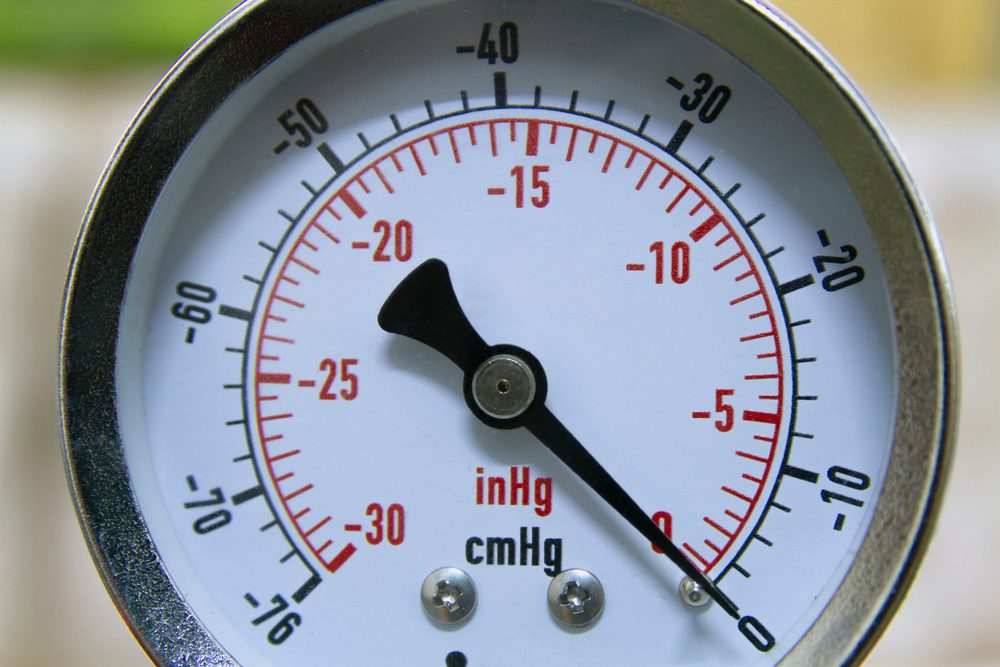
The range, amount of pressure, and climatic conditions of the fluid being monitored determine which of the vacuum gauges should be used.
What are Vacuum Gauges?
A vacuum gauge helps measure pressure. The pressure it reads is the pressure in the actual vacuum. Pressure in a vacuum can differ from atmospheric pressure.
You can find vacuum gauges in air pumps, compressors, and other mechanical setups. Mechanics and builders are typical users of vacuum gauges. Engineers also use a vacuum gauge to evaluate the quality and effectiveness of a finished system.
What are the Three Types of Vacuum Gauges?
There are three main categories pressure gauges based on their mechanism of action and construction.
Manometers
Four types of manometers used to measure pressure differences are the:
- Barometer
- U-tube manometer
- Inclined manometer
- Piezometer
The simplest manometer is a U-shaped tube with an open end and a port linked to a container containing the fluid whose pressure has to be measured. To begin with, the liquid column height is the same on both sides. However, the height of the mercury column shifts as gas or liquid enters through the valve. The pressure is quantified by tracking the rise or fall of the mercury barometer.
Elastic element pressure gauges
The four types of elastic element pressure gauges are the:
- Diaphragm pressure gauge
- Capsule pressure gauge
- Bellows tube
- Bourdon tube
Diaphragm pressure gauges can be used to accurately measure the pressure of both gases and liquids in the pressure range of 10 to 40 mbar.
The metering component is a circular diaphragm sandwiched between two flanges. By applying either positive or negative pressure to this diaphragm, a proportional deformation occurs, which moves the display hand.
Electrical pressure gauges
Magnetic, Capacitive, Resonant, Thermal Conductivity, and Strain Gauge transducers are only a few of the many categories into which electric pressure gauges fall.
Strain Gauge
Between the vacuum and the atmosphere is a flexible diaphragm, often composed of stainless steel, that shifts in response to pressure. The strain gauge connected to the diaphragm responds to this motion by altering the electrical resistance, which is then transmitted to the screen as a signal. Pressure, mass, and torque measurements, as well as sensors for location, all benefit from the usage of this instrument.
Thermocouple Vacuum Pressure Gauges
A Thermocouple Vacuum Pressure Gauge called a Pirani Gauge uses a platinum filament as a thermometer exposed to environmental pressure. Electric current warms the wire, and gas pressure can modify its temperature. Increased gas density may suggest increased pressure, which induces thermal conduction.
Ionization Pressure Gauges
Ionization Pressure Gauges are sensitive in high vacuum ranges. By monitoring ions created by electron bombardment of gas molecules, they indirectly measure pressure. Low pressure produces fewer ions. These gauges measure 10-10 to 10-3 Torr.
Ionization Pressure Gauges are sensitive in high vacuum ranges. By monitoring ions created by electron bombardment of gas molecules, they indirectly measure pressure. Low pressure produces fewer ions. These gauges measure 10-10 to 10-3 Torr.
Mid-West Instrument
Midwest Instrument is an industry leader in manufacturing and designing differential pressure gauges, transmitters, and switches. With over 60 years of experience, you can rest assured that we have all the skills, time, equipment, technology and workforce to get you the best products in the industry. Feel free to contact us to learn how our products can help you today!

